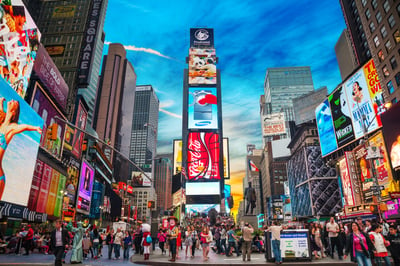July 9, 2025
 by Lesley Vos / July 9, 2025
by Lesley Vos / July 9, 2025

Green isn’t a trend. It’s a test. And right now, your customers are watching to see if your brand passes it.
Sustainability has become a business expectation. Consumers are choosing brands that back up their values, not just their price tags. If your marketing still treats eco-friendly as a buzzword, you're already behind.
Green marketing is how brands turn climate responsibility into a competitive edge. It connects what you make and how you sell with what matters to your audience: transparency, impact, and integrity.
Green marketing is the practice of promoting products or services based on their environmental benefits. It includes using sustainable materials, reducing carbon footprints, and highlighting eco-friendly practices in production, packaging, or distribution.
Recognizing this, companies are now adopting a green marketing strategy to address the areas of environmental, social, and governance practices in their branding and to create a positive impact on customers.
Integrating green marketing through sustainability management software can be the initial step toward fostering hope for sustainability in industrial businesses.
In this guide, we’ll break down how to do green marketing the right way. That includes smart strategy, real-world examples, and best practices.
The whole concept of green marketing centers around four major P's on which a brand must devise its strategy. Being aligned with these four parameters ensures that you have checked every box of gaining the standard of a green brand.
| Pillar | What it means | Real-world applications |
| Product | Develop products using sustainable, recyclable, or responsibly sourced materials | Refillable packaging, compostable materials, and recycled-content goods |
| Price | Reflect environmental and ethical values in your pricing model | Pricing that supports fair wages, carbon offsets, and long-term durability |
| Place | Deliver products through low-impact, eco-conscious channels | Local fulfillment, electric delivery vehicles, and minimal-waste shipping |
| Promotion | Communicate your sustainability efforts clearly, honestly, and with evidence | Impact-driven campaigns, certified claims, transparent storytelling |
Let's dive deeper into what these 4 Ps are, the brand deliverables, and where you need to implement them.
This involves using environmentally friendly raw materials and practices to manufacture and assemble your product. It can also mean spearheading social awareness campaigns for organic product supplies and leaning out your entire production to highlight the importance of earthly resources. Green products are also defined as modifying existing products and incorporating sustainability and environmental friendliness into the development process.
This is a humble initiative to reward the laborers and artisans who developed the product. Putting a specific price bracket could highlight the product's environmental benefits, recycling capability, and zero wastage, which might entice the audience to purchase the product and consider the potential threats to our planet.
This focuses on distributing green products through channels that emit zero fuel or carbon footprint, like manual sourcing, eco-friendly paper packaging, and electric vehicle dropshipping. The idea is to ensure that the brand doesn't harm the environmental health in any way.
Green promotion involves promoting the eco-friendliness of your products and highlighting the initiatives you have taken to protect and conserve natural resources through advertisements. The process is fixated on putting your brand in the spotlight and depicting the earthiness and humble objective of your product in the market. This encourages people to make environmentally responsible decisions.
The line between genuine sustainability and surface-level eco claims is thinner than ever. That’s why it’s critical to understand the difference between these two and ensure your brand ends up on the right side of it.
-png.png?width=600&height=375&name=_containers%20as%20a%20service%20vs%20infrastructure%20as%20a%20service%20(4)-png.png)
The image above illustrates what is green marketing vs. greenwashing.
It involves the genuine development, distribution, promotion, and selling of products that have been manufactured in a sustainable way. The companies building such products are often after a larger cause that will positively impact the planet. Although generating profits is a crucial goal, these brands contribute to a larger spectrum of humanity by ensuring that their product benefits their customers.
They often partner with environmentally friendly agencies to spread awareness among people. They spend their money and sweat on generating recyclable products, reducing their carbon footprint, and cutting down energy consumption by a considerable percentage.
It is a malicious technique through which brands keep their target audience in the dark by luring them into believing that they follow green marketing practices. It is a deceptive way of duping customers and charging them more money by claiming false patents, board approvals, and misleading advertising.
Greenwashing has become common in today's business scenario and makes it impossible for consumers to strike a difference between real and fake brands. Greenwashing is a marketing gimmick that uses false digital campaigns and visuals to capture consumer baits and push them toward sales.
In the present age, green marketing is advantageous and a priority considering the fast depletion of natural resources. Switching or tweaking your business with green marketing can have the following benefits.
To help weigh the opportunity clearly, here’s a side-by-side look at the key benefits and challenges of adopting a green marketing strategy.
| Benefits of green marketing | Challenges of green marketing |
| Builds long-term brand loyalty through shared values | Higher production and sourcing costs |
| Differentiates your brand in crowded markets | Consumer skepticism due to greenwashing |
| Supports regulatory compliance and ESG benchmarks | Requires complex supply chain adjustments |
| Drives innovation in sustainable product design | Customer education is often needed to justify value |
| Improves brand reputation and social impact perception | Rapidly changing sustainability standards can create uncertainty |
Some aspects of green marketing sound too good to be true — not just to us but even to the customers who spectate these brands. Here are some challenges associated with green marketing.
Green marketing is a revolutionary strategy that has empowered global brands to makeshift their business operations and contribute towards the betterment of the world. Here are the five best green marketing practices to join the revolution.
As part of green marketing, brands often participate in recycling programs, become more scrupulous about waste disposal practices, donate to different green movements, and educate their customers about what they do to protect the environment and why it matters.
To integrate green marketing into your overall business brand marketing strategy, you can do the following:
In other words, twist green into a part of your brand's identity. To make it work, commit to green marketing in your marketing plan. This includes green design, positioning, pricing, logistics, and disposal. When making environmental consciousness a number one focus of your business, you succeed with sales and consumer loyalty. In the long term, green brands get more profits and establish a trustworthy reputation.
The examples listed below are socially responsible, considering the long-term environmental impacts of their business practices. They have launched green marketing campaigns to promote sustainable core values. They surpass traditional marketing strategies, educating people about conscious consumption. Here's how.
Patagonia contributes to climate change issues and works on discovering sustainable ways to produce products. At the same time, the brand is honest with customers, admitting it's not entirely green: The shells of coats are made of fossil fuels. But this fact doesn't influence the brand's positive image, as the community sees its sincere passion for helping the planet.
The company's mission states Patagonia's green marketing strategy and involvement in the Go Green movement. It also regularly donates millions to initiatives supporting sustainable agriculture practices, protecting endangered species, and restoring forests.

Source: Patagonia
Starbucks has been certified by LEED since 2005, but it has moved beyond that by planning to eliminate all plastic straws by 2020 and open 10,000 environmentally friendly stores by 2025.
Starbucks tries hard to engage its community in sustainable issues. It uses green materials for producing, packaging, and delivering its products to customers. As part of its Green Store initiative, the brand plans to reduce waste and use 30 percent less water and 25 percent less power during production processes.
The brand designs disposable coffee cups, is involved in recycling and green building, supports farmers and the environmentally sustainable community, and has been hard at communicating this message to its target audience.

Source: Starbucks
World-known clothing manufacturer and retailer Timberland uses sustainable stories to introduce its products. As active LOHAS supporters, its clients wouldn't choose the brand if there was no green element in it.
"We’ve done a lot of consumer research, and we know that if we put two products side-by-side – one from our brand and one from a competitor’s – and if they’re comparable in price and quality, the majority of the time, a customer will choose our product if it’s made with some sort of ‘green’ element," said Margaret Morey-Reuner, director of Timberland’s strategic partnerships and business development.
To develop and implement the corresponding green marketing strategy, the company continues to expand partnerships and test materials for its products. It has established environmental standards (TEPS) across all product categories and 100 percent organic and renewable material in the near future.
Timberland also gained a lot of prominence due to their "nature needs heroes" campaign where they nosedived into sustainable fashion and sculpted their brand message as a retail brand that is wary of climatic conditions and greenhouse effect on the earth and wants to create one of a kind goods that embrace change and sustainability.
Read more about timberland and their sustainability marketing campaign to be more aware of how seriously are brands taking this initiative.
This brand uses many tactics and sources to manage waste and renew energy. Ninety percent of its buildings have solar panels, it uses wind farms to generate energy, and it has planted millions of trees, while sending only 15 percent of waste to landfills.
Ikea has developed a strategy known as People & Planet Positive, encouraging consumers to be environmentally conscious. It manufactures products through eco-friendly practices, which relieves us from the necessity to choose between stylish design and sustainability.
The brand holds many rewards for its green efforts. It's recognized by the Impact Company for showing respect for human and economic rights, as well as its contribution to the environment through regenerative efforts. And Ikea isn't going to stop there, it is currently working toward 100 percent renewable energy and spending a fortune on its green initiatives.

Source: IKEA
This brand is known for its effective green positioning. The Body Shop is approved by Leaping Bunny, the gold standard for non-animal tested products. It also supports farmers, defends human rights, initiates health treatments and training events for employees, identifies its values as to protect the planet, and – what's more important – actually lives up to those values.
The Body Shop is known for promoting awareness of domestic violence and AIDS, and it doesn't use demeaning-to-women images in ads. The brand's goal is to develop cruelty free and sustainable products, use 10 percent less and 100 percent renewable energy in stores, eco friendly packaging and more.

Source: bodyshop.com
Other noteworthy green marketing campaigns:
Green marketing involves promoting products or services with environmental characteristics, brand modification, and changes in the manufacturing process.
It's about taking a different perspective on marketing, considering the global consequences of environmental degradation. It's about a brand's ability to satisfy customer needs with minimum environmental harm. Given that, a new marketing paradigm emerged, with the concept that consumers have an active role in brands' green initiatives, obtaining sustainable benefits.
In 2025, sustainability is no longer a niche selling point. It's a standard that customers expect and regulators enforce. As climate concerns grow and greenwashing risks increase, brands are adapting their marketing strategies with smarter tools, clearer proof, and deeper engagement.
Here are three key trends defining green marketing this year:
In response to consumers' desire for real proof, companies are using blockchain tracking, carbon labeling, and QR-enabled packaging to show how and where products are made, what emissions are involved, and which certifications they meet.
This level of supply chain transparency helps brands move from vague “green” language to verifiable claims, reducing the risk of greenwashing and increasing consumer trust.
AI in green marketing isn’t just about personalization; it’s about precision and efficiency. Brands are using it to segment eco-conscious audiences, optimize ad placements, and reduce redundant campaign assets.
Paired with smart automation, AI helps teams scale sustainability messaging with less content waste, fewer emissions from digital delivery, and messaging that actually lands with the right audience at the right time.
More brands are turning sustainability into a two-way conversation by promoting reuse, recycling, and return programs. Whether it’s clothing trade-ins, refill incentives, or upcycled packaging, circular marketing turns post-purchase behavior into a brand touchpoint.
Smart campaigns are now educating consumers on how to participate and rewarding them for doing so. It’s not just about selling a greener product; it’s about keeping it in use longer and building loyalty through shared responsibility.
Got more questions? We have the answers.
Clarity, consistency, and proof. Customers respond best to specific, measurable claims, like how much packaging waste was reduced or how many products were returned for reuse. Avoid vague phrases and focus on real impact.
Many consumers prefer participatory campaigns. Whether they bring in used products for a discount, join a local sustainability challenge, or follow a brand’s climate journey online, engagement often grows when customers feel like collaborators, not just buyers.
Yes, if the messaging is honest. Customers are open to progress over perfection, as long as brands clearly share what they’re doing, what they’ve achieved, and where they’re headed. Authenticity matters more than claiming to be “100% green.”
When customers feel their purchase supports something meaningful, like environmental restoration or ethical sourcing, they're more likely to stay loyal. Brands that consistently communicate their values and show progress build stronger emotional connections with buyers.
Overpromising. Many brands focus on the appearance of sustainability without the action to back it up. This erodes trust quickly. The best strategies start with substance, then build messaging around the real work being done.
For those willing to join green marketing and show love for our planet, focus on brand content to let the world know about your endeavors. The most effective platforms are your website, blog, and social media pages.
Promote your eco-friendly marketing to environmentally aware consumers, build an emotional connection with them, and make green efforts a part of your brand's story. Show the audience what's in your business beyond money-making and marketing.
Learn more about how to water your brand to success with five impactful sustainable business practices to boost the ecosystem.
This article was originally published in 2024. It has been updated with new information.
Lesley is a content creator with 9+ years of experience in web writing. Currently blogging at several educational blogs, she's also contributing to many publications on business, marketing, and lifestyle.
Your brand isn't just a logo, it's the feeling you evoke, the values you champion, and the...
 by Jordan Wahl
by Jordan Wahl
Brand exposure is one of the most critical yet often underleveraged drivers of marketing...
.png) by Devyani Mehta
by Devyani Mehta
There is greater strength in numbers, especially when competition is involved.
 by Hannah Tow
by Hannah Tow
Your brand isn't just a logo, it's the feeling you evoke, the values you champion, and the...
 by Jordan Wahl
by Jordan Wahl
Brand exposure is one of the most critical yet often underleveraged drivers of marketing...
.png) by Devyani Mehta
by Devyani Mehta


